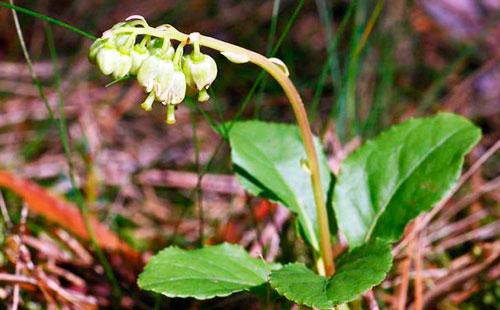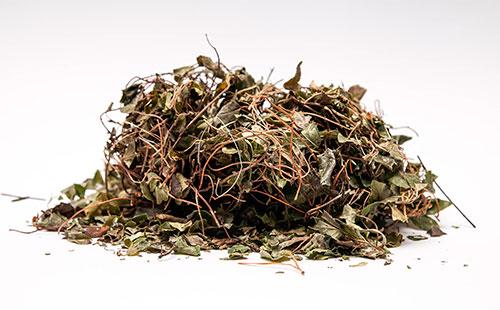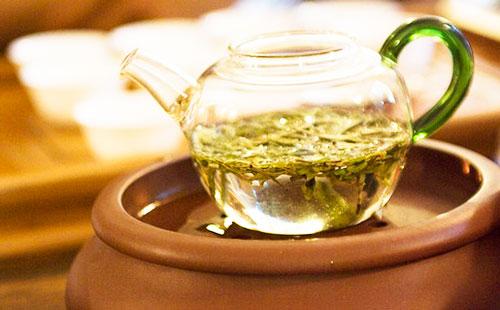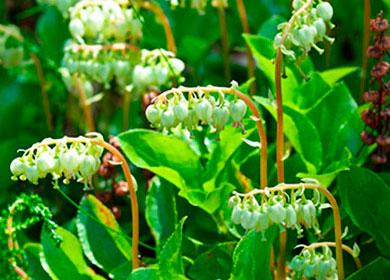The content of the article
The healing properties and contraindications of the uterus were well known in Russia. This grass is found not only in ancient Russian herbalists, but also in legends and beliefs. It is considered to be female grass, and in ancient images it was painted next to the female silhouette and the Moon. First of all, the plant was used as a unique remedy for infertility. Be sure to take into account the phase of the moon when collecting and receiving miraculous grass. However, in other ethnic groups (for example, among the British, Irish, Germans, Canadians) they do not know anything about the use of this plant for medicinal purposes. In Alaska, this herb is eaten, tea is made from it. Boron grass as a medicinal plant for "female diseases" is revered precisely in the culture of the Eastern Slavs - Russians, Ukrainians, Belarusians.
Features of the hog uterus
Side-bloom, forest pear, wine grass, bar uterus, ortilia is one-sided - all this is one and the same plant. In the people, this medicinal plant is more often called the “pine forest uterus” (in modern Russian it sounds like a “forest mother”). What is so special about this grass? What are its healing properties? What the plant looks like, you can look at the photo. And why is there such a stir around her on the Internet, especially on women's websites and forums?

Area
Where does the boron uterus grow? This is a “resident” of the Northern Hemisphere. It takes root well in the European part of Russia, in the Ciscaucasia region, in the Far East. Grass is also found in England, Germany, France, Canada and the United States. He loves a moist forest zone, less commonly found in clearings, clearings, and edges. More often it can be seen in swamps and meadows, the plant takes root in the tundra, develops well in darkened, cool places. Siberia (Altai) is considered to be the birthplace of the uterus of the uterus, there are glades overgrown with this grass.
Botanical characteristic
The shoots of this perennial herb are small - from 5 to 25 cm. But the root is long and branched, with a large annual growth. Grass is well established on depleted soils. The leaves are alternate, of a small oval shape (up to 8 mm), located at the bottom of the stem. The flowers are racemose, drooping, greenish-white, in the form of small, serrated bells. They are collected in a one-sided inflorescence.

How to harvest grass
A valuable medicinal raw material is considered to be the whole aerial part, especially the leaves. The root is not used. Harvest time depends on climatic conditions, but must be carried out during the flowering period - approximately in July-August. How to dry the grass?
- Lay out in a thin layer.
- Turn over the raw materials periodically.
- It is possible to dry in the open air, but so that sunshine did not get to a grass.
- Can be dried indoors with good air circulation.
- Dry grass is stored for 2 years.
Altai shamans collected pine grass only on the full moon. Therefore, the plant was attributed not only medicinal, but also magical power.

Chemical composition, pharmacological action
- What are the healing properties of the uterus? A wide spectrum of the pharmacological action of the plant was discovered - diuretic, antitumor, antiseptic, immunostimulating, expectorant, analgesic, antispasmodic. In addition, orthilium is a natural hormone. Grass is taken to rejuvenate the body, normalize blood pressure during hypertension, and strengthen the cardiovascular system.
- What is the chemical composition? Estrogen and progesterone are precisely those natural phytohormones that regulate women's health and the reproductive system. For example, if a woman does not have enough progesterone, her probability of conception is reduced, pain during menstruation appears, and a threat of miscarriage is created. The estrogen contained in orthilia helps to cope with the female body during menopause and makes menopause less painful psychologically and physiologically. What other useful substances does it contain? Organic acids, antioxidants (a lot of vitamin C), saponins, coumarins, flavonoids, bitterness, resins, tannins, a rich composition of trace elements.
Unfortunately, the instructions for use of tincture of the uterine uterus (and other dosage forms) do not mention highly toxic substances in its composition. The most dangerous of them are coumarins, hydroquinone, arbutin. For example, coumarins thin the blood and can cause uterine bleeding.

What diseases are good for taking?
Indications for the use of the uterus in the first place are various gynecological diagnoses and symptoms. These include:
- endometriosis;
- myomauterine fibroma;
- adhesions in the pelvis;
- infertility;
- mastopathy;
- cervical erosion;
- candidiasis, or thrush;
- inflammation of the vaginal mucosa (vaginitis, colpitis);
- inflammation of the fallopian tubes (salpingitis);
- ovarian cyst;
- menstrual irregularities;
- the absence of menstruation for several cycles (amenorrhea), the irregularity of the cycle;
- hormonal disorders;
- menopause;
- premenstrual syndrome (PMS).
In addition to gynecology, the plant is used in other areas of scientific medicine:
- endocrinology: Boron grass can be included in complex therapy in case of thyroid gland, adrenal gland malfunction, it treats diabetes mellitus;
- urology: the grass acts as a diuretic and antiseptic, it is useful for cystitis, pyelonephritis and other urogenital infections;
- gastroenterology: in complex therapy treat hemorrhoids, disorders of the liver and gall bladder.
What are contraindications
Strict contraindications for the uterus:
- allergy to a herbal preparation;
- gastritis;
- blood coagulation diseases (grass dilutes blood), against their background there may be heavy menstruation;
- suspected ectopic pregnancy;
- pregnancy and lactation;
- obstruction of the fallopian tubes.
Application in traditional and traditional medicine
Orthilia one-sided was introduced into the State Pharmacopoeia in 2003, that is, it is officially recognized as a drug and is practiced in scientific medicine. But the experience of treating this herb in folk medicine has hundreds of years.
Dosage Forms
One-sided orthilia can be purchased at a pharmacy in various dosage forms. It is important to know that the therapeutic effect does not depend on the form, but on the dosage and duration of the course.
- Picking grass. You can buy dry grass and brew it yourself. From it at home, decoctions, infusions, alcohol and oil tinctures are prepared.
- Pills. The tablets contain a one-sided dry extract of ortilia. There are tablets with the addition of other herbs, for example, yarrow. The drug belongs to the group of dietary supplements. Indicated therapy may last up to 4 months. You can also purchase the drug in capsules. In the instructions for tablets, the hormonal and restorative effect of the herbal preparation, which is prescribed for the complex treatment of inflammation of the female reproductive system, is primarily indicated.
- Alcohol tincture of the boron uterus. Its composition includes an extract of grass leaves and ethyl alcohol. The bottle contains 50 ml of liquid. Drops must be dissolved in ½ cup of water. How to take a tincture of the boron uterus? A single dose of the medicine should not exceed 35 drops, you can take the medicine no more than 3 times a day. The instructions indicate the average dosage and duration of the course, but it is also emphasized that the doctor prescribes the medicine in each individual case.
- Tea. The composition can be pure pine grass, the addition of green tea or the collection of herbs. Herbal tea is recommended as a dietary supplement not only for treatment, but also for prevention. Drink tea once a day (recommended in the evening, an hour after eating). To prepare a drink, use 1 sachet, pouring a glass of boiling water. Insist 5 minutes, drink in a warm form.
- Syrup. Volume - 250 ml. Sugar is used as a preservative, therefore, the drug should not be taken by people with diabetes. Take 1 tsp. three times a day 30 minutes before meals. The course of treatment can be long - up to six months with interruptions.
- Candles Made on the basis of castor oil. They are prescribed not only for gynecological disorders, but also for cystitis, pyelonephritis, and other diseases of the urinary system.
In some instructions, you can read the information that after taking boron grass, symptoms may worsen, but you need to “endure” and continue treatment. In no case should you follow this advice. Exacerbation and side effects can be associated with individual intolerance, be a sign of intoxication of the body.

Features of use in gynecological diseases
Is it worth mentioning that before starting treatment with pine grass for any diagnoses, examination and consultation of a gynecologist is required. The doctor prescribes hormone tests. The doctor should see a picture of the hormonal background and only after that can prescribe an adequate course of treatment. During the course of therapy, as well as after treatment, ultrasound is usually prescribed, as well as repeated tests to see what hormonal changes have occurred in the body.
- Pine uterus with endometriosis. Endometriosis - the growth of endometrial cells (layer of the walls of the uterus). The causes of these violations are not fully understood. It was found that an excessive growth of the endometrium provokes an excess of estrogen in the body of a woman in the first phase of the cycle, as well as a low level of progesterone in the second. With the help of the uterus, it is possible to reduce the functioning of the ovaries and, accordingly, to reduce the level of estrogen. If a woman has undergone conservative or surgical treatment of endometriosis, the doctor may prescribe an herb to prevent relapse.
- Pine uterus with myoma. Myoma (fibromyoma) is a benign tumor in the muscle layer of the uterus. One of the reasons for the formation is hormonal disruption. Most often, in the treatment of this disease, herbs are used - red brush and hog uterus. Reviews of women about the treatment of fibroids with these agents are both positive and negative.In some, the myoma resolves in several cycles, in others it increases, sometimes the treatment ends with surgery. It is better not to rely on reviews, but still trust your doctor.
- Pine uterus for conception. The causes of infertility can be very different: obstruction of pipes, adhesions; urinary tract infections; inflammatory processes of the genital organs (including after abortion), endometriosis, immunological and hormonal disorders. If the cause of infertility is associated with hormonal failure, the doctor may prescribe the herb in combination with other drugs. Why is specialist consultation and hormone analysis so important? You need to know in which phase of the cycle it is better to take boron grass, and when it will be ineffective and even harmful. The grass can be drunk for three months, then you must definitely take a break. Many women after taking the boron uterus note malfunctions of the menstrual cycle, abundance or scarcity of menstruation, jumps in basal temperature, and a decrease in signs of PMS. But there may also be complaints of headaches, nausea, exacerbation of latent or chronic female infections. If pregnancy has occurred while taking the drug, it is recommended to gradually reduce the dose of grass. Abrupt withdrawal can cause a hormonal jump and provoke a miscarriage.
- Pine uterus with cervical erosion. With this disease, douching with a decoction of grass is recommended. Also, the infusion is taken orally. The causes of erosion can be very different, and one of them is hormonal failure. In addition, this disease can develop against the background of a decrease in immunity. For douching, it is necessary to cook a fresh broth each time (take 2 tbsp. L of grass per 500 ml of water). The procedure is performed before bedtime. The course of treatment lasts no more than 7 days, so as not to disturb the vaginal microflora. Then, if necessary, repeat it. Also, with erosion of the cervix, you can put tampons moistened with decoction of ortilia. Your doctor may recommend vaginal suppositories made from pine forest grass.

Features of the preparation and reception
How to brew grass? From it you can make decoctions, water infusions, alcohol and oil tinctures. When brewing and filtering is not recommended to use metal utensils.
Preparation of alcohol tincture
- Take 500 ml of vodka and 3 tbsp. l dry grass.
- Insist 3 weeks in a dark place.
- Shake the tincture periodically.
Before starting the reception, it is necessary to strain the tincture. For preventive purposes, they drink small doses - 15 drops an hour before meals 2-3 times a day.
Cooking broth
- Pour 1 tbsp. l herbs with a glass of boiling water.
- Hold in a water bath for 5 minutes.
- Let it brew for 30 minutes.
- Strain.
The broth can be taken orally (1 tbsp. L. Three times a day) and applied externally - for douching. The broth can also be used as an antiseptic for the skin; it heals purulent wounds well. Store in the refrigerator, use within 2 days.
Cooking infusion in a thermos
- Put in a thermos 2 tbsp. l herbs.
- Pour 2 cups boiling water.
- Insist 2 hours.
The infusion is filtered and poured into a dry glass dish. Store in the refrigerator for no more than 3 days.
Some important questions
Women abroad do not raise such questions because they have not heard anything about this wonderful grass. “They” trust scientific medicine more. Unfortunately, our women often prefer to discuss their diseases not in the doctor’s office, but in women's forums.
- Is it possible to drink the uterus with menstruation? Grass can not be taken during menstruation. It has already been mentioned that this plant dilutes the blood, which can lead to heavy monthly, uterine bleeding.
- What is the compatibility of the boron uterus and Duphaston? Phytohormone is not recommended to be taken together with other synthetic hormonal drugs. Dufaston is no exception. This drug is prescribed for progesterone deficiency, which provokes various disorders of the reproductive system.An increase in progesterone can lead to various disorders, first of all, to a malfunction of the menstrual cycle. Some gynecologists-endocrinologists are in no hurry with the appointment of hormone replacement therapy and, with hormonal imbalances, they suggest observing the state for several cycles if there is no uterine bleeding. Any intervention in the endocrine system can produce unpredictable results. Reception of the uterine uterus is also an intervention in the natural hormonal system. This must not be forgotten.
- What are the doctors' opinions about the uterus? Gynecologists of domestic and foreign medicine do not deny the effectiveness of herbal medicine for female diseases. Pine uterus can help during menopause, it relieves pain with PMS, inflammation of the female genital organs. And many domestic gynecologists include it as an additional tool in complex therapy. There are also negative opinions about the "fashionable weed." More often they can be heard from gynecologists who practice abroad. It is believed that the grass is not only not effective in infertility, but even harms. Abroad, a number of studies were conducted in patients with a diagnosis of infertility. The results of the study showed that in women who used medicinal herbs for conception, the chances of pregnancy were lower than in other groups of women with this diagnosis. Grass can cause a miscarriage in the early stages.
- Why is the boron uterus prohibited during pregnancy? From the moment of conception, a real “hormonal revolution” begins in the woman’s body. If you connect additional phytohormones to this process, they can lead to a miscarriage. Therefore, gynecologists do not recommend this plant during pregnancy.
- How to take a boron uterus and a red brush together? The red brush (the botanical name is “four-membered Rhodiola”) is another popular “female herb” that normalizes hormonal levels and is widely used in gynecology. To enhance the therapeutic effect, the doctor may prescribe a simultaneous intake of pine grass and a red brush. This collection is especially effective for fibroids, mastopathy, fibroma, uterine bleeding. In the pharmacy, you can buy ready-made drops. You can also prepare a collection at home. It is important to consider the time of administration and dosage. Treatment takes place according to this schedule: 2 weeks take a collection, then 1 or 2 weeks take a break. According to this schedule, treatment takes place in 4 stages. The general course of treatment takes about 4 months. Dosage: 1 tbsp. l 3 times a day. Admission conditions: strictly an hour before meals. In case of malfunctions of the menstrual cycle, gynecologists recommend drinking a red brush in the first phase, and boron grass will be more effective in the second.
Security measures
How to drink a boron uterus? Once again, we emphasize the rules for safe reception:
- drink only as directed by a doctor;
- maintain dosage and schedule;
- take breaks during menstruation;
- do not combine with other hormones;
- when taking any other medicines, you should inform your doctor;
- drink in courses;
- take hormone tests for control;
- if side effects and an allergic reaction occur, consult a doctor immediately.
The use of pine grass in men
Pine uterus for men can also be useful for diseases of the genitourinary sphere, infertility. The grass increases sexual activity, potency, increases the number and motility of sperm, has a beneficial effect on the immune system, and is useful for middle-aged and older men. Tincture of pine forest in combination with other drugs helps in the treatment of adenoma and prostatitis. It acts as an analgesic, anti-inflammatory, antiseptic, antitumor agent, resolves adenomas well.
Recently, the use of the uterus in domestic folk medicine has become increasingly popular. Female grass is increasingly prescribed by gynecologists, including in the complex treatment of disorders of the female genitourinary tract.However, the abundance of pharmacy advertising and the promotion of "miracle grass" in the masses makes some doctors look at it with skepticism. First of all, this concerns the treatment of female infertility.

